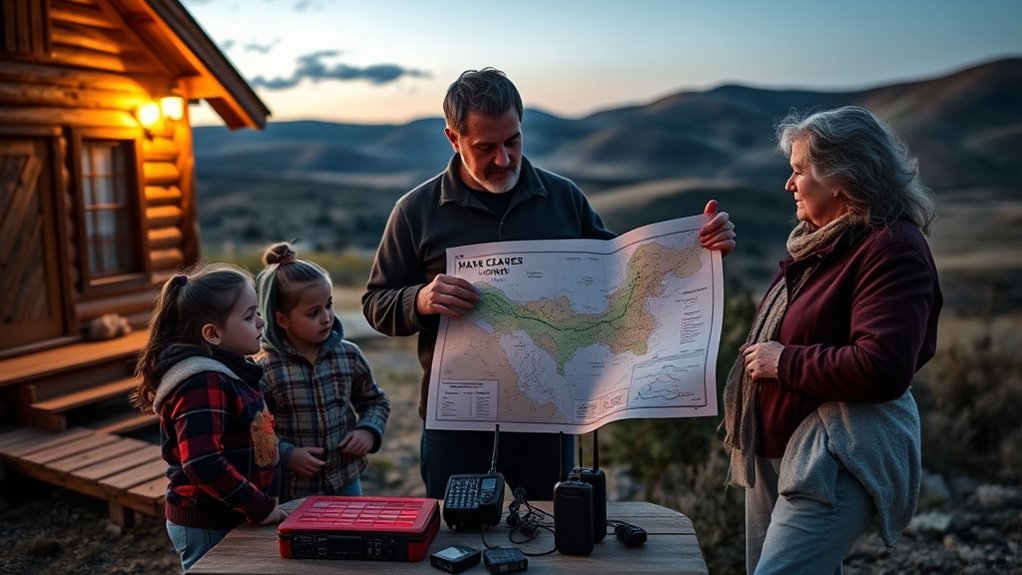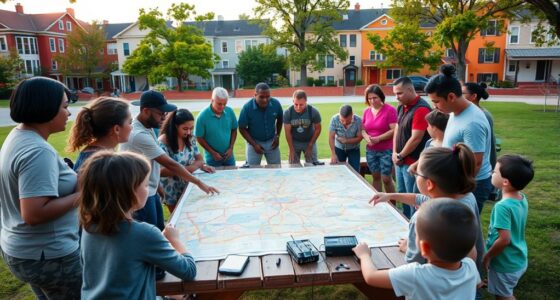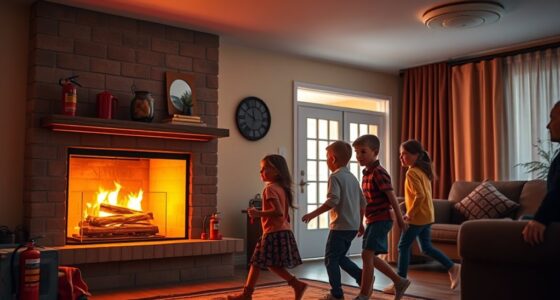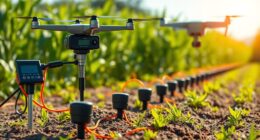To create a family emergency communication plan for rural areas, first establish designated meeting spots both near your home and outside your neighborhood. Share contact details of trusted relatives or friends outside the area, and guarantee everyone knows how to reach them if local services are down. Practice your plan regularly, including drills that simulate communication failures. Make sure your devices, like two-way radios or satellite phones, are charged and accessible. Stay open to new solutions—your safety depends on it.
Key Takeaways
- Establish clear meeting points both at home and outside the neighborhood for family reunification.
- Create and share a list of emergency contacts outside your immediate area to facilitate communication.
- Develop a written emergency communication plan, including step-by-step procedures and backup contacts.
- Practice regular drills with family members to test and improve your communication plan’s effectiveness.
- Use reliable, battery-powered devices like two-way radios or satellite phones as backup communication methods.

In rural areas, where cell signals can be unreliable and emergency services may take longer to arrive, having a solid family emergency communication plan is essential. When disaster strikes—whether it’s a storm, wildfire, or accident—you need to be prepared to stay connected with your loved ones and coordinate your actions effectively. One of the first steps is assembling an emergency kit that includes essential supplies such as water, non-perishable food, first aid supplies, flashlight, batteries, and any necessary medications. An emergency kit ensures that your family can sustain itself if you’re temporarily cut off from outside help or communication.
In rural areas, an emergency kit with essentials helps your family stay safe if communication lines are down.
Equally important is establishing reliable communication devices. While cell phones are your primary tools, they may not always work in rural areas during a crisis. To address this, consider investing in alternative communication devices like two-way radios or satellite phones. These devices can operate independently of cell towers and provide a dependable way to stay in contact with family members or emergency responders. Make sure everyone in your family knows how to use these tools and keeps them charged and accessible at all times. Additionally, understanding the reliability of communication methods can help you choose the best devices for your situation, especially given the limitations of rural connectivity. Being aware of the types of backup communication available ensures you are prepared for various scenarios. Incorporating advanced communication technology can further enhance your preparedness, especially as new solutions become available.
Designing a communication plan involves setting clear, predetermined methods for staying in touch. For example, decide on a designated meeting spot near your home and another outside your neighborhood in case you’re separated. Agree on a list of emergency contacts outside your immediate area—such as relatives or friends in different locations—so you have backup options if local communication lines are down. Share these contact details with all family members, and ensure everyone understands the plan’s steps.
Practicing your communication plan regularly helps everyone remember what to do during an actual emergency. Conduct drills where you simulate a situation where cell signals are lost or communication devices need to be used. During these exercises, verify that all communication devices are functioning and that each family member knows how to operate them. Additionally, keep printed copies of your emergency plan and important contact information in your emergency kit or a safe, accessible place. This practice enhances familiarity and readiness, especially when technology might fail.
Ultimately, a well-thought-out family emergency communication plan combines an emergency kit with reliable communication devices and clear procedures. In rural areas, where help may be delayed and signals are spotty, this preparation can make all the difference. By staying connected and knowing how to communicate effectively, you protect your family and increase your resilience in the face of unexpected events. Remember, preparation today can save lives tomorrow. Moreover, understanding the importance of biodiversity can help communities recognize their role in protecting local ecosystems that provide vital resources and services during emergencies.
Frequently Asked Questions
How Often Should I Update My Rural Family Emergency Plan?
You should review your emergency plan at least once a year to guarantee it stays current. Regular plan reviews help identify any needed changes, especially as circumstances evolve. Conduct family drills periodically, ideally twice a year, to practice communication procedures and improve response times. Updating your plan regularly and practicing together ensures everyone knows their role, making your family better prepared for emergencies.
What Are the Best Low-Cost Communication Tools for Rural Areas?
You should consider using wireless radios and community bulletin boards as low-cost communication tools. Wireless radios allow you to stay connected during emergencies without relying on cell service. Community bulletin boards, whether physical or digital, help share critical updates quickly within your neighborhood. These options are affordable, easy to maintain, and effective for timely communication, ensuring everyone stays informed and safe during emergencies.
How Can I Ensure My Plan Works During a Power Outage?
Think of your plan as a lifeline in a storm—you need it to hold firm during blackouts. To guarantee it works during a power outage, invest in a solar backup to keep essential devices charged. Additionally, keep battery-powered radios handy so you can receive updates even when the grid’s down. Regularly test these tools to confirm they’re functioning, so you’re prepared when an emergency strikes.
Are There Local Resources to Help Develop an Emergency Plan?
You should explore local support options and planning workshops in your area to develop an effective emergency plan. Community centers, local government offices, and nonprofit organizations often offer resources and training sessions that help you create tailored strategies. Attending these workshops allows you to learn from experts, connect with neighbors, and guarantee your plan addresses specific rural challenges. This hands-on approach strengthens your preparedness and boosts confidence in handling emergencies.
How Do I Include Vulnerable Family Members in the Plan?
Picture a sturdy bridge supporting everyone’s safety. To include vulnerable family members, prioritize special needs and guarantee clear communication. Coordinate with caregivers, sharing detailed plans and emergency contacts. Use visual aids or devices if needed, and practice drills together. This way, you build a resilient connection, making sure no one feels left behind during emergencies, and everyone’s needs are understood and addressed seamlessly.
Conclusion
Even in rural areas where cell towers are few and landlines unreliable, your family’s emergency plan might just be your greatest safety net—until a power outage or storm strikes, leaving you all in silence. Ironically, the very effort to stay connected can sometimes be thwarted by the very nature of rural life. But with a solid plan in place, you’ll at least have peace of mind—knowing that, no matter what, you’re prepared for the chaos.









